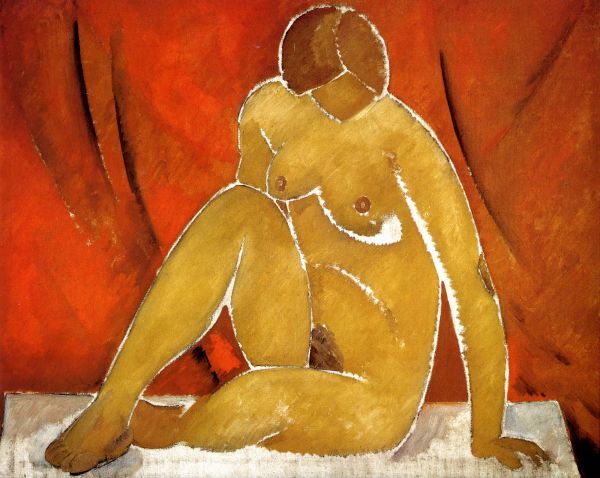|
|
Artist’s Model. 1913

Tatlin Vladimir,
Oil on canvas
104,5 x 130,5
Annotation
In 1912, following his break with Mikhail Larionov and his group, Vladimir Tatlin opened his own studio on Ostozhenka in Moscow, where he and a group of followers painted nude models. Tatlin’s large paintings were influenced by the works of Pablo Picasso, which the Russian artist could see in the private collections of Sergei Schukin and Ivan Morozov and at exhibitions of modern French painting in Moscow. Seeking his own form of Cubism, Tatlin borrowed liberally from the traditions of Old Russian icon-painting.
Artist’s Model reflects his tendency towards generalisation, synthesis and the plastic significance of form. The large colour planes, the role of the silhouette and the simplified contour of the figure add expressiveness to the artistic quests. The rhythmic and constructive forms and the laconic tones are justified in respect to the correlations of the masses and the patches of colour. Opening new doors in art, Tatlin successfully combined the expressive plastics of Old Russian icon-painting and Cubism.
Author's Biography
Tatlin Vladimir
Tatlin, Vladimir Yevgrafovich
1885, Moscow -1953, Moscow
Painter, graphic artist, theatrical designer, author of architectural and engineering projects. Studied at the Penza School of Art (1904-10) and under Valentin Serov and Konstantin Korovin at the Moscow School of Painting, Sculpture and Architecture (1902-03, 1909-10). Contributed to the exhibitions of Donkey''s Tail (1912), Jack of Diamonds (1913), World of Art (1913), Union of Youth (1910-14), Tramcar V. First Futurist Exhibition (1915), 0,10. Last Futurist Exhibition (1915-16) and Store (1916). Member of the Unification of New Trends in Art (1922-23). Chairman of the Left Federation of Artists in Moscow (1917), head of the Moscow committee of Narkompros (1918-19). One of the initiators of the creation of the Museum of Painterly Culture, Museum of Artistic Culture and the Institute of Artistic Culture. Headed the department of material culture at the Institute of Artistic Culture. Taught in Petrograd, Kiev and Moscow. Headed the Narkompros Experimental Laboratory (1929-32

